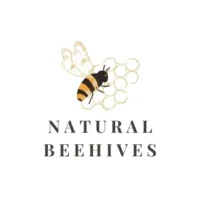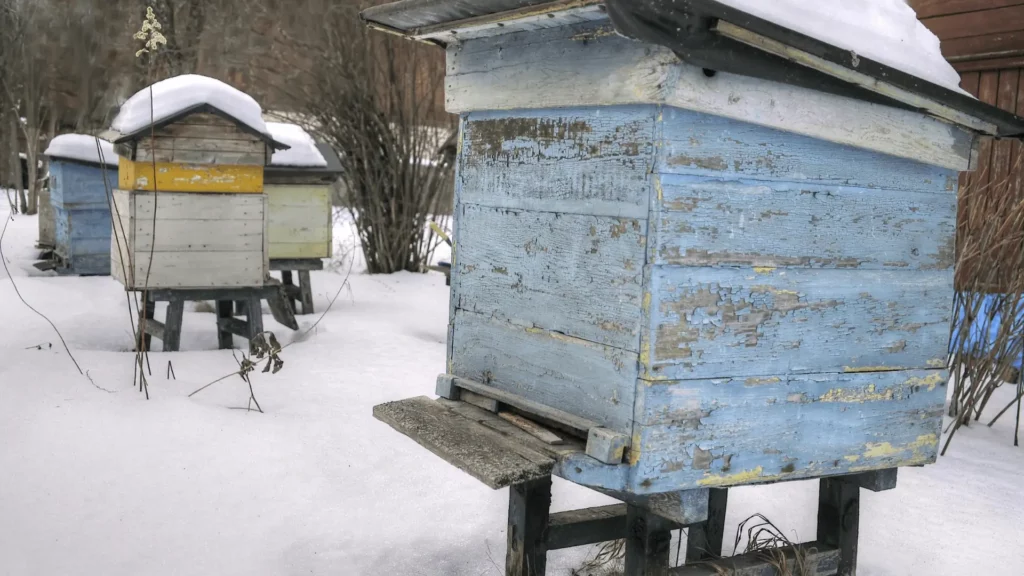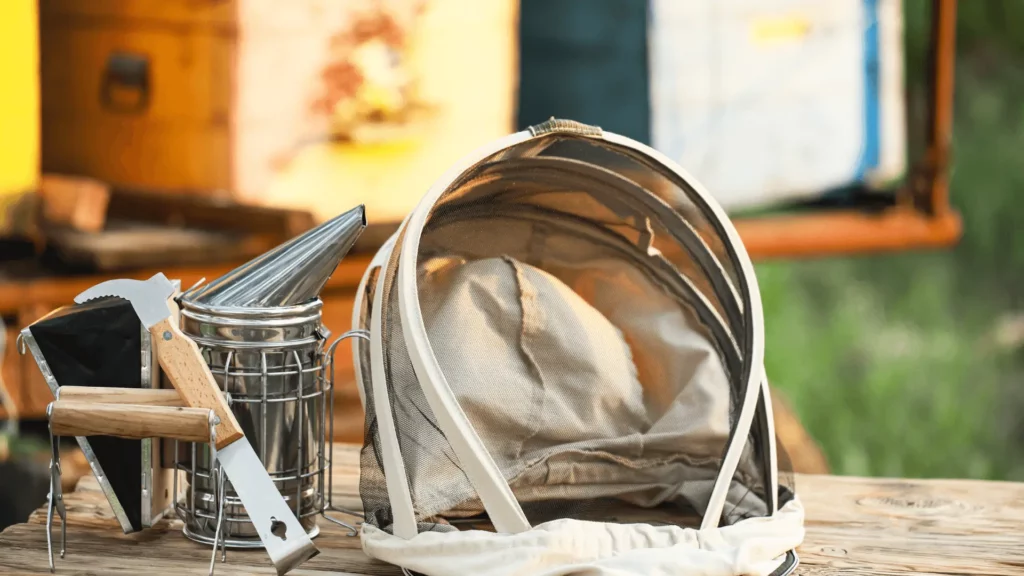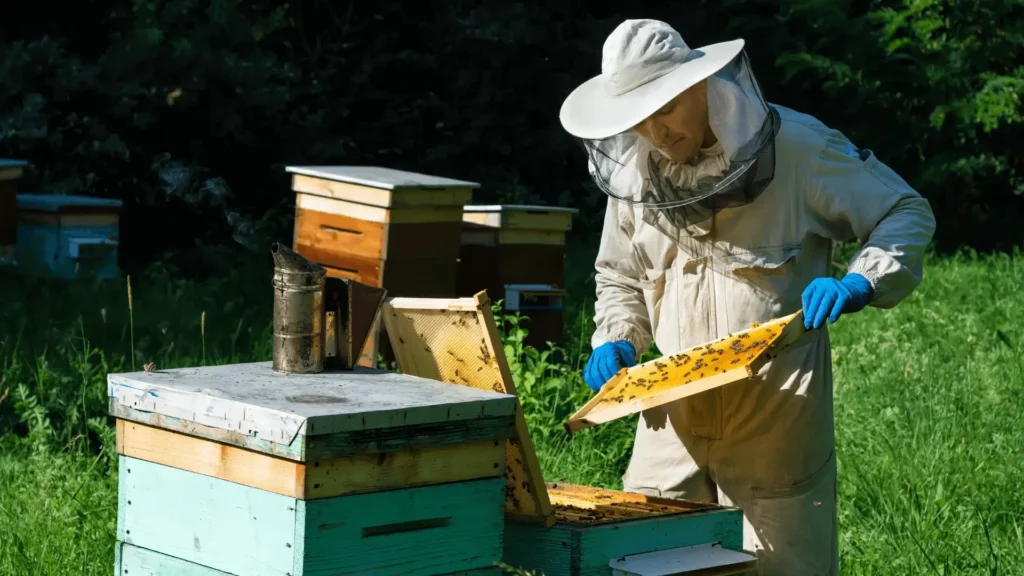
Are you an aspiring beekeeper, ready to embark on your buzzing journey? Well, we’ve got you covered. When it comes to beekeeping, having the right tools is essential for a successful and fulfilling experience. From the practical hive tools to the nifty pocket knives and everything in between, we’ve compiled a comprehensive guide of must-have tools that every beekeeper should own.
In this article, we’ll walk you through the essential tools that will make your beekeeping venture a breeze. We’ll discuss the benefits of specific tools and how they can streamline your process, saving you time, effort, and maybe even a few stings along the way. Whether you’re a beginner just getting started or a seasoned beekeeping pro looking to upgrade your toolbox, we’ve got expert recommendations and insights to help you make informed decisions.
So, if you’re ready to ensure the success of your hive, keep reading as we unveil the tools that will make your beekeeping experience sweeter than honey. Let’s dive in and equip you with the knowledge you need to become the ultimate beekeeper!
Introduction to Must-Have Tools for Beekeepers
Beekeeping is an intricate and rewarding hobby that requires the use of specialized tools to ensure the well-being of your colonies. Having the right tools is essential for efficient hive management, bee health monitoring, and overall success in this venture. By equipping yourself with the must-have tools for beekeeping, you’ll be better equipped to handle the various tasks involved and create a thriving beekeeping experience.
The tools you choose should be designed to ease your work, provide protection, and assist in maintaining the health of your bees. These tools range from hive tools, sugar water sprays, pocket knives, nitral gloves, and much more. Each tool serves a specific purpose and contributes to the smooth functioning of your beekeeping operations.
Whether you’re a novice beekeeper or an experienced enthusiast, understanding the significance of these tools will support your efforts in creating a favorable environment for your beloved bees. In the following sections, we’ll explore the importance and functionality of each must-have tool, offering valuable insight into their role in successful beekeeping.
Hive Tool – The Beekeeper’s Swiss Army Knife
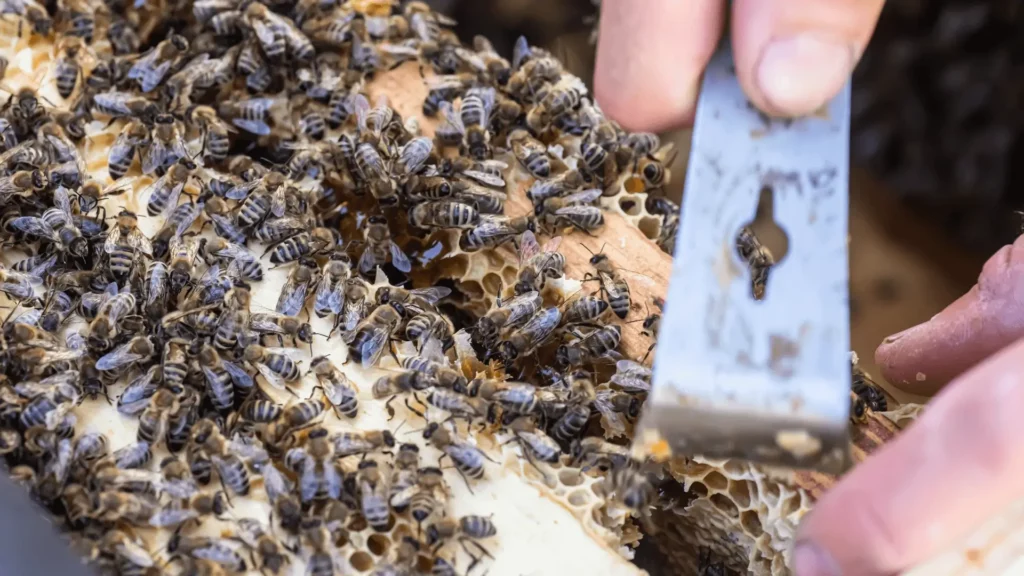
The hive tool is a versatile and essential tool that no beekeeper should be without. It serves as the beekeeper’s Swiss Army knife, tackling a variety of tasks to ensure smooth hive management. Let’s explore the uses and importance of this invaluable tool.
Opening Hives with Ease
One of the primary functions of the hive tool is its ability to pry open beehive components. With its flat, sturdy blade, the hive tool makes it easy to separate supers, remove frames, or pry off sticky propolis. This allows for efficient and gentle hive inspections, minimizing disruption to the bees and reducing the risk of damaging the hive.
Scraping and Cleaning
The hive tool also comes in handy when scraping away excess wax or propolis. The hooked end of the tool allows beekeepers to scrape and clean frame tops, removing any unwanted buildup. This ensures proper bee space and prevents the frames from sticking together. Additionally, the hive tool can be used to scrape off excess burr comb and propolis from hive components, maintaining a clean and hygienic environment for the bees.
Frame Manipulation
When inspecting frames, the hive tool provides leverage for easy frame removal. The notch on one end of the tool can be used to lift and pry frames from the hive, allowing beekeepers to examine each frame individually. This facilitates thorough inspections, helping beekeepers monitor the health and productivity of the colony.
Swarm Management
During swarming season, the hive tool is essential for swarm management. Beekeepers can use the tool to gently pry apart crowded frames and carefully capture the queen and her swarm. This ensures the safe relocation of the swarm, preventing the loss of valuable bees and minimizing disturbance to neighboring colonies.
Sugar Water Spray – Nourishing Your Bees
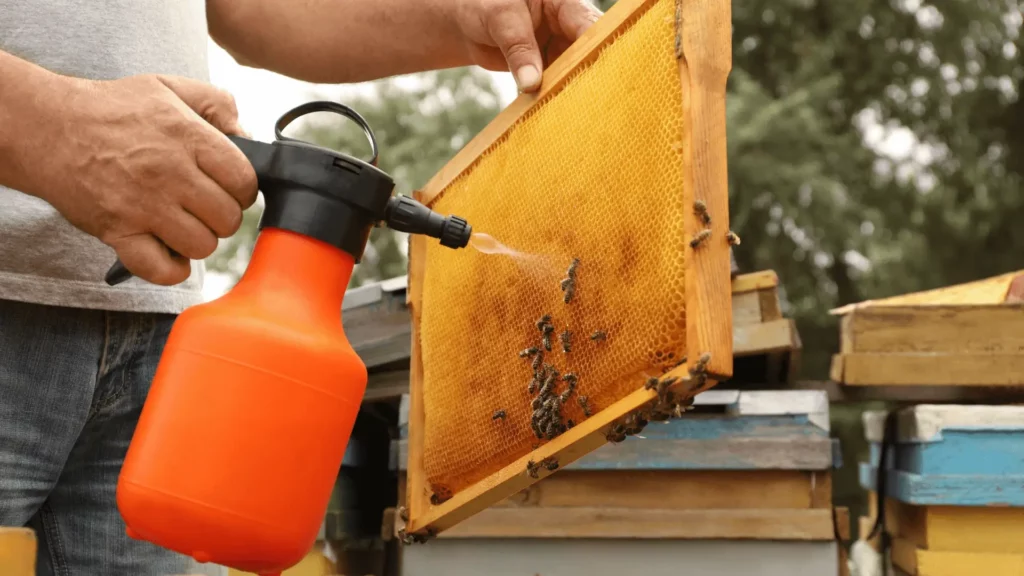
One essential tool in a beekeeper’s toolbox is the sugar water spray. This simple yet effective tool plays a crucial role in feeding and hydrating bees, ensuring their health and well-being. Let’s explore the benefits of using a sugar water spray in more detail.
Feeding and Hydration
Bees require a steady supply of nectar and water to survive and thrive. However, in certain situations, such as during periods of drought or when there is a shortage of available nectar sources, bees may need additional nourishment. This is where the sugar water spray comes in handy. By misting a fine spray of sugar water near the hive entrance or directly on the frames, beekeepers can provide a supplementary food source for their bees.
Stimulating Brood Production
Sugar water sprays are particularly useful during periods when brood production needs to be stimulated. By providing a readily available source of carbohydrates, beekeepers can encourage the queen bee to lay more eggs and increase the population of the colony. This can be especially beneficial in the spring when bee populations are recovering from the winter months.
Medication Administration
In some cases, beekeepers may need to administer medications or treatments to their hives. The sugar water spray can serve as a vehicle for delivering these substances to the bees. By mixing the medication or treatment with sugar water, beekeepers can ensure that it is evenly distributed among the colony, promoting overall hive health.
Hydration in Extreme Weather Conditions
During hot summer days, bees may struggle to find water sources to cool their hives. Supplying a sugar water spray can help quench their thirst and prevent dehydration. Additionally, in freezing temperatures, honey may become too thick for the bees to consume. Offering a sugar water spray can provide them with a more easily accessible and liquid food source.
Pocket Knife – A Handy Multi-Purpose Tool
A pocket knife is like the Swiss Army knife of beekeeping, offering a multitude of uses that make it an essential tool for every beekeeper. From cutting comb to repairing equipment, a pocket knife is a versatile companion in the beekeeping journey.
Cutting Comb
One of the primary uses of a pocket knife in beekeeping is cutting comb. When inspecting the hive, there may be instances where you want to remove or trim excess comb. A pocket knife with a sharp blade allows you to make precise cuts, ensuring clean removal without damaging the surrounding comb.
Repairing Equipment
Beekeeping equipment, such as frames and hive boxes, may require occasional repairs. A pocket knife comes in handy for various repair tasks, such as fixing loose joints or removing excess propolis. Its small and portable design makes it easy to carry around and use whenever needed.
Uncapping Honey
During the honey harvesting process, beekeepers need to uncap the honeycomb to extract the honey. A pocket knife with a serrated edge or a specialized honey uncapping blade can efficiently and effectively remove the wax cappings, allowing easy access to the honey.
Emergency Situations
Being prepared for unforeseen circumstances is crucial for any beekeeper. A pocket knife can be valuable in emergency situations, such as cutting through vegetation to access a hive or freeing a bee from entanglement.
Marking Equipment
Beekeepers often mark their equipment for identification and organization purposes. Whether it’s labeling frames or marking hive boxes, a pocket knife can be utilized to carve small markings or initials, aiding in easy identification and management.
A pocket knife is undoubtedly a versatile and handy tool that no beekeeper should be without. Its compact size, portability, and various applications make it an essential component of a well-equipped beekeeping toolbox. With a pocket knife by your side, you’ll be ready to tackle a wide range of beekeeping tasks with ease and precision.
Nitral Glove – Protection and Dexterity
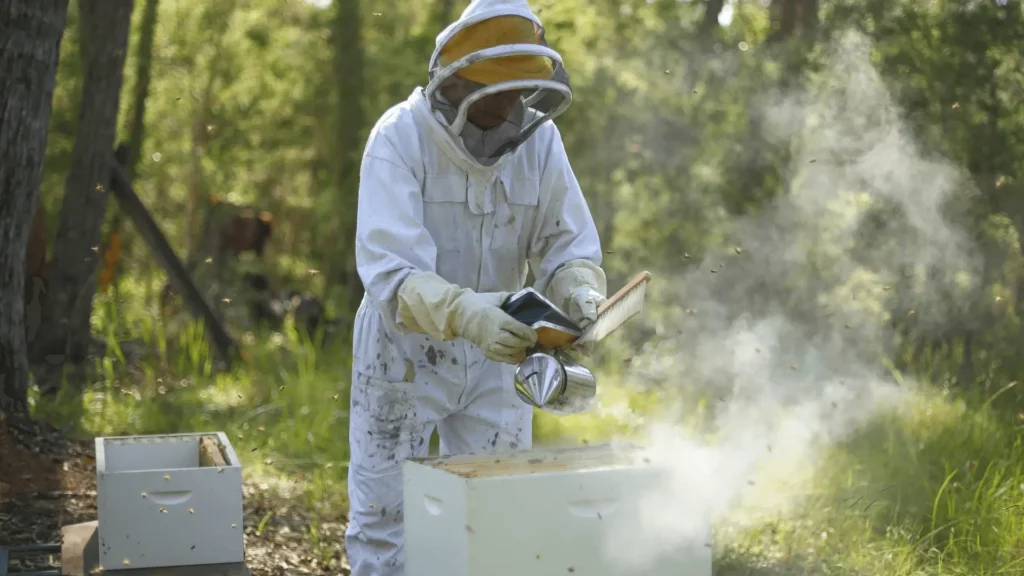
When it comes to beekeeping, protection and dexterity are essential. One tool that offers both is the nitral glove. These gloves are designed specifically for beekeepers, providing a barrier between their hands and the bees while allowing for maximum flexibility and sensitivity.
Importance of Wearing Nitral Gloves
Wearing nitral gloves is crucial for beekeepers for several reasons.
Protection from Stings
First and foremost, nitral gloves offer protection from bee stings. Bee stings can cause discomfort and in some cases, severe allergic reactions. By wearing nitral gloves, beekeepers can minimize the risk of getting stung and protect their hands from painful encounters.
Dexterity for Precise Movements
While protection is important, beekeepers also need to have precise control over their movements when handling bees. Nitral gloves are thin and lightweight, providing excellent dexterity for tasks such as inspecting hives, manipulating frames, and collecting honey. They allow beekeepers to handle delicate bees and equipment with confidence and precision.
Hygiene and Disease Prevention
Another benefit of wearing nitral gloves is that they help maintain hygiene and prevent the spread of diseases within the hive. By using gloves, beekeepers can avoid transferring bacteria or pathogens from their hands to the bees or hive components, reducing the risk of contamination.
Comfort and Longevity
Nitral gloves are comfortable to wear, allowing beekeepers to work for extended periods without discomfort. Additionally, these gloves are durable and resistant to tears and punctures, ensuring they can withstand the rigors of beekeeping tasks.
Duct Tape – The Beekeeper’s Quick Fix
In the ever-resourceful world of beekeeping, one tool stands out as a must-have for any beekeeper’s toolbox: duct tape. As a versatile and dependable item, duct tape is the go-to solution for quick repairs and fixes in the apiary.
The Importance of Duct Tape in Beekeeping
1. Securing Hive Components: With its strong adhesive properties, duct tape comes in handy when securing hive components and preventing unwanted movements. Whether it is holding together cracked wooden frames or patching up gaps in hive boxes, duct tape provides a temporary fix until more permanent solutions can be implemented.
2. Equipment Maintenance: Beekeepers often encounter small equipment issues during hive inspections. Duct tape acts as a quick and easy fix for repairing minor damages to beekeeping tools, such as torn bee suits or damaged veils. It ensures that beekeepers can continue their work without interruptions or safety concerns.
3. Hive Repairs: When encountering hive damage, such as cracks or gaps, duct tape offers a temporary solution until proper repairs can be made. It helps to maintain hive integrity, keeping bees safe and protected from external elements.
4. Emergency Situations: Duct tape is an essential tool during unexpected situations, such as a broken hive or damaged comb. By using duct tape to stabilize hive components or temporarily seal cracks, beekeepers can quickly address emergencies and prevent further damage.
Pill Box – Organizing Small Beekeeping Supplies
A well-organized beekeeping toolbox is essential for smooth and efficient hive management. One tool that can greatly contribute to keeping your beekeeping supplies organized is a pill box. This small and versatile container offers several benefits that can simplify your beekeeping tasks.
Benefits of Using a Pill Box
1. Organization: A pill box provides individual compartments, allowing you to neatly store and separate small items such as queen markers, small screws, or other essential beekeeping supplies. With everything in its designated place, you can easily locate items when needed, saving time and reducing frustration during hive inspections.
2. Portability: Pill boxes are lightweight and compact, making them perfect for on-the-go beekeepers. Whether you’re attending workshops or traveling to different apiaries, a pill box can easily fit in your beekeeping bag or pocket, ensuring you have essential small items readily available wherever you go.
3. Protection: The individual compartments of a pill box provide protection for delicate items like queen markers or beekeeping tools with sharp edges. By preventing these items from accidentally colliding or getting damaged, a pill box helps preserve the overall quality and lifespan of your beekeeping supplies.
4. Easy Identification: With clear lids or transparent compartments, pill boxes allow for quick and easy identification of the stored items. This visual clarity ensures that you can easily spot and retrieve the specific supplies you need without wasting time rummaging through a cluttered toolbox.
Incorporating a pill box into your beekeeping toolbox can significantly enhance your organization, time management, and overall efficiency. By neatly storing and separating small beekeeping supplies, you’ll be able to streamline your hive inspections and focus on the tasks that matter most for the health and productivity of your bee colonies. Invest in a pill box today and experience the benefits firsthand.
Bee Brush – Gentle Bee Handling
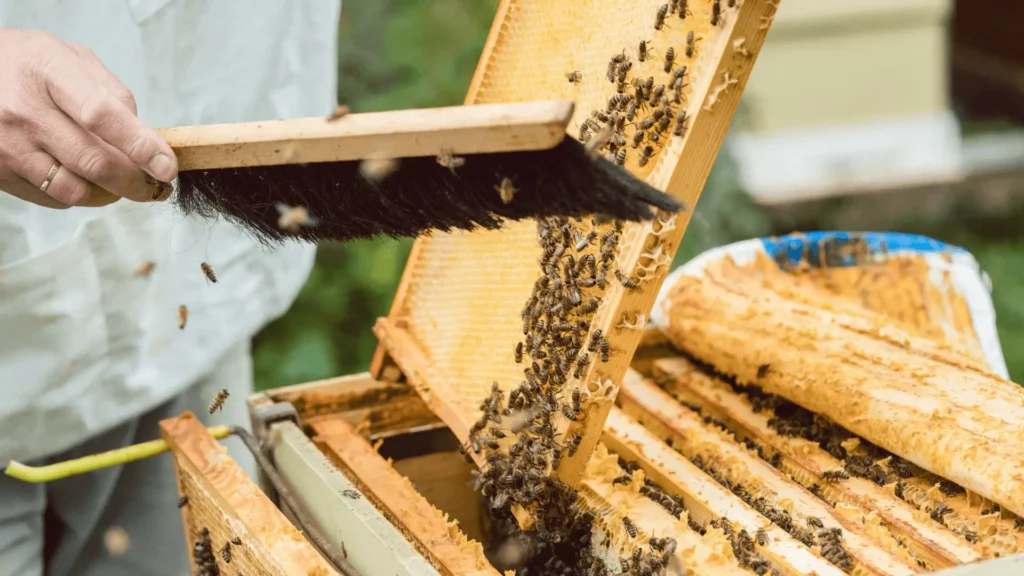
When it comes to inspecting beehives and managing your bees, one important tool that every beekeeper should have in their toolbox is the bee brush. This gentle tool is specifically designed to handle bees without causing harm or agitation.
Purpose of a Bee Brush
The primary purpose of a bee brush is to gently remove bees from frames or other surfaces during hive inspections. This tool allows beekeepers to carefully maneuver bees and ensure a thorough examination of the hive without squishing or injuring any of the delicate insects.
Gentle Bee Handling
Bee brushes are made with soft bristles that are designed to be gentle on bees. The bristles are usually made from horsehair or synthetic materials, ensuring a smooth and non-abrasive touch. When using a bee brush, it’s essential to handle the bees softly, brushing them away in a calm and controlled manner.
Benefits of Using a Bee Brush
Using a bee brush during hive inspections offers several benefits. Firstly, it allows you to remove bees from the frames, making it easier to examine them closely for disease or other issues. Secondly, it helps prevent accidental injury to the bees and disturbance to their delicate comb structure.
Tips for Using a Bee Brush
When using a bee brush, it’s important to follow some best practices to ensure the safety and well-being of your bees:
1. Approach the bees calmly and gently.
2. Use the brush in a controlled and precise manner, avoiding any quick or aggressive movements.
3. Gently sweep the bees away from the frame, ensuring they are displaced and not harmed.
4. Be mindful not to brush too hard, as you don’t want to damage the bees’ delicate wings or bodies.
5. Always remember that bees are essential to the hive’s functioning and should be handled with care and respect.
Feather Duster – Gentle Hive Cleaning
One of the must-have tools in a beekeeper’s arsenal is a feather duster. This simple yet versatile tool serves a crucial purpose in hive maintenance – gentle hive cleaning. With its soft, flexible bristles, the feather duster allows beekeepers to clean honeycomb and remove beeswax debris without causing harm to the hive or its occupants.
Benefits of Using a Feather Duster
1. Gentle Cleaning: The soft bristles of a feather duster provide a delicate touch, ensuring that the honeycomb remains intact while removing any excess debris. This gentle cleaning technique is essential for maintaining a healthy and productive hive.
2. Removing Beeswax Debris: Beeswax buildup can hinder the proper flow of air and impede the bees’ movement within the hive. By using a feather duster, beekeepers can effectively remove this debris, allowing for better ventilation and easier navigation for the bees.
3. Avoiding Disruption: Unlike other cleaning tools that may cause disturbance or stress to the bees, a feather duster allows beekeepers to clean without alarming or agitating the hive’s inhabitants. This minimizes the risk of aggression and ensures a peaceful hive environment.
Proper Technique for Hive Cleaning
To make the most of your feather duster for hive cleaning, follow these guidelines:
1. Gentle Strokes: Use light and delicate strokes with the feather duster to remove beeswax debris from the honeycomb. Avoid applying excessive pressure that could damage the comb or harm the bees.
2. Thorough Cleaning: Pay attention to all areas of the hive, including the frames, corners, and crevices. Ensure that the feather duster reaches into hard-to-reach spaces to remove any hidden debris.
3. Regular Maintenance: Incorporate hive cleaning with a feather duster as part of your routine hive inspections. Regularly clean the honeycomb to prevent the accumulation of beeswax debris and maintain a hygienic hive environment.
Frame Holder – Ease of Hive Management
A frame holder tool plays a crucial role in the smooth management of beehives during inspections. This essential tool provides beekeepers with a secure and convenient way to hold frames, making hive inspections and manipulations easier and safer.
Benefits of Using a Frame Holder
1. Stability: By securely holding the frames in place, a frame holder prevents accidental dropping or mishandling of frames, ensuring the safety of the bees and the beekeeper.
2. Hands-Free Inspection: With a frame holder, beekeepers can have both hands free to perform various tasks during inspections, such as checking for queen cells, inspecting brood patterns, or carrying out necessary hive manipulations.
3. Precise Positioning: The frame holder allows beekeepers to position frames at the desired angle for optimal viewing, making it easier to observe the health and condition of the hive.
4. Reduced Stress: With the frames securely held, beekeepers can work with more confidence and reduced stress, knowing that their valuable bees and comb are protected from accidental damage or disruption.
Types of Frame Holders
1. Standard Frame Holder: This type of frame holder consists of two prongs or clips that securely grip the frame, providing stability and convenience during inspections.
2. Magnetic Frame Holder: Some frame holders utilize magnets to hold the frame in place, offering additional stability and ease of use.
3. Hands-Free Frame Holder: Designed to be attached to the hive or beekeeper’s clothing, this hands-free frame holder allows beekeepers to have their hands completely free while still keeping the frames within easy reach.
Proper Use and Safety Precautions
To effectively use a frame holder and ensure the safety of the bees and the beekeeper, it is important to follow these guidelines:
– Always handle frames with care to avoid unnecessary agitation to the bees.
– Keep the frame holder clean and free from debris, ensuring a secure grip on the frames.
– Use the frame holder in a well-lit area to facilitate thorough inspections and prevent accidental damage.
Zip Tie – Securely Fastening Hive Components
In the world of beekeeping, where hive components need to stay securely in place, zip ties prove to be a versatile and indispensable tool. These small plastic straps with a fastening mechanism are essential for ensuring the stability and integrity of hive structures. Here’s why every beekeeper should have zip ties as part of their toolbox:
Preventing Unwanted Movements
The primary purpose of zip ties in beekeeping is to prevent unwanted movements of hive components. By securely fastening frames, supers, and other hive parts together, zip ties ensure that the structure remains intact and stable, even during transport or inclement weather. This stability is crucial to avoid any disturbance to the bees or damage to the hive.
Easy Installation and Versatility
Zip ties are incredibly easy to use, making them a favorite among beekeepers. With a simple loop and pull mechanism, they can be quickly attached and removed whenever necessary. Additionally, zip ties come in various sizes and lengths, allowing them to accommodate different hive components and provide a secure fit.
Cost-Effective Solution
Zip ties provide a cost-effective solution for fastening hive components. They are relatively inexpensive and readily available, making them a practical choice for both beginner and experienced beekeepers. With their durability and reusability, zip ties offer long-lasting value for the investment.
Promoting Hive Stability and Safety
By securely fastening hive components, zip ties minimize the risk of accidental opening or collapsing of the hive. This promotes the overall stability and safety of the hive, reducing the chances of damage and bee stress. It also allows beekeepers to work more confidently during hive inspections or maintenance tasks.
Also read: The Ultimate Beekeeping Starter Kit: Everything You Need to Get Started
Queen Catcher – Safely Managing the Queen
A queen catcher tool is a beekeeper’s indispensable ally when it comes to safely capturing and managing the queen bee during hive manipulations. This specialized tool allows beekeepers to handle the queen with care, minimizing the risk of harm or injury to both the beekeeper and the queen herself.
Importance of Safely Managing the Queen
The queen bee is the heart of the colony, responsible for laying eggs and ensuring its survival. Her smooth and gentle handling is critical to maintain the overall health and productivity of the hive. By using a queen catcher, beekeepers can safely isolate and examine the queen without causing disruption to the rest of the colony.
How Does a Queen Catcher Work?
A queen catcher typically consists of a small plastic or metal cage with openings designed to allow the worker bees to enter while preventing the queen from escaping. It enables beekeepers to carefully trap the queen inside the catcher while leaving the worker bees outside. This way, the queen can be easily observed, marked, or transferred to another hive if necessary.
Steps to Safely Catch the Queen
To safely catch the queen using a queen catcher, follow these steps:
1. Locate the queen: Carefully search the frames until you spot the queen among the bees.
2. Gently surround the queen with the catcher: Place the catcher over the queen, ensuring she is fully enclosed.
3. Confirm the queen’s presence: Verify that the queen is securely trapped inside the catcher before proceeding.
4. Complete the desired manipulation: Once the queen is safely caught, you can perform various hive manipulations such as marking her or moving her to a different hive.
5. Release the queen: After completing the necessary actions, carefully release the queen back into the hive, making sure she is free from harm.
Best Practices for Queen Catching
When using a queen catcher, remember to:
– Handle the catcher and queen with extreme care to avoid injuring or stressing the queen.
– Minimize the duration of confinement to reduce the potential impact on the queen’s overall well-being.
– Use soft and steady movements when catching and releasing the queen to prevent sudden movements that might startle her.
BBQ Starter – Fast and Reliable Hive Smoking
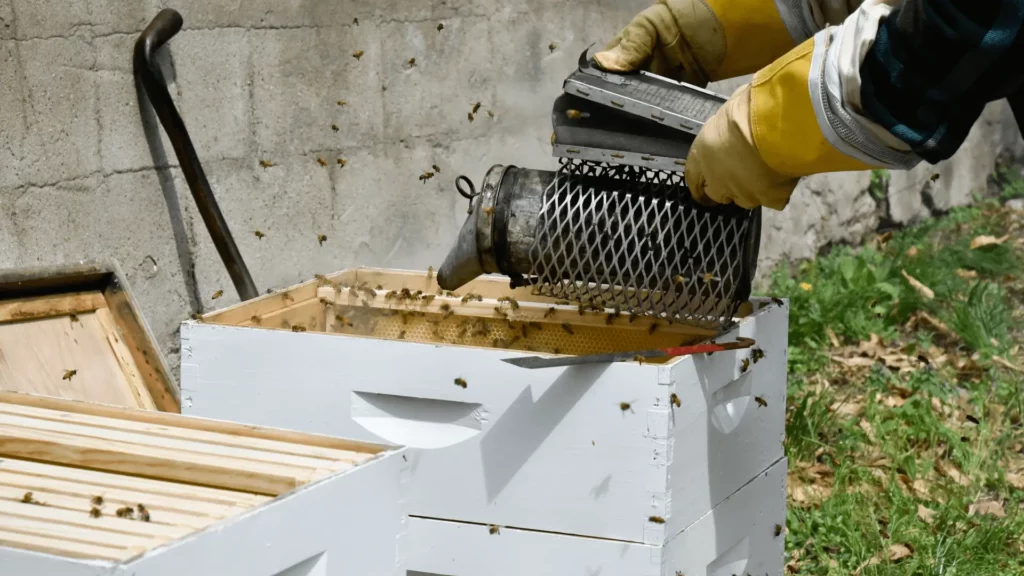
When it comes to hive inspections, one essential tool in a beekeeper’s arsenal is the BBQ starter. This simple yet effective tool provides fast and reliable hive smoking, an important technique to calm bees and make hive inspections less invasive. Here’s why a BBQ starter is a must-have tool for beekeepers:
Efficient and Consistent Smoke Production
With a BBQ starter, beekeepers can quickly produce a steady stream of smoke. The design of the starter allows for efficient combustion of fuel, creating a consistent smoke output. This is crucial during hive inspections as the smoke helps mask alarm pheromones, reducing the chances of bees becoming agitated and defensive.
Fast Ignition and Long-Lasting Smoke
A BBQ starter enables rapid ignition of fuel, saving precious time during hive inspections. The tool’s chimney design allows for efficient airflow, resulting in a fire that quickly catches and spreads throughout the fuel. This ensures a long-lasting smoke that can be continuously provided throughout the inspection process.
Versatility in Fuel Options
Another advantage of using a BBQ starter for hive smoking is the flexibility in fuel choices. Beekeepers can opt for various materials depending on their preferences and availability, such as dried twigs, pine needles, or specific smoker fuels designed for beekeeping. This versatility allows beekeepers to experiment with different fuel combinations to find what works best for their hives.
Portable and Easy to Use
The compact and lightweight nature of a BBQ starter makes it a convenient tool for beekeepers to carry during hive inspections. Its simple operation involves filling the starter with the chosen fuel, igniting it, and directing the smoke towards the hive entrance or through the hive’s top ventilation. The ease of use ensures that beekeepers can focus on the task at hand without unnecessary distractions.
Remember, when using a BBQ starter for hive smoking, it’s important to be mindful of fire safety. Always use the tool in a well-ventilated area, away from flammable materials, and have a fire extinguisher or water source nearby as a precaution.
Importance of a Well-Equipped Bee Yard
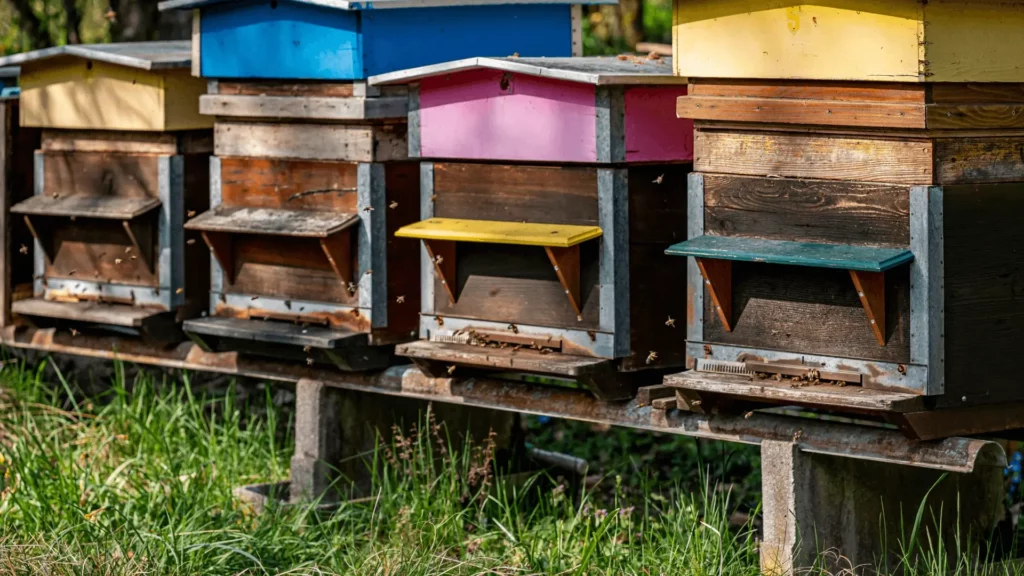
Setting up a well-equipped bee yard is essential for successful beekeeping. Having the right tools and equipment not only ensures a smooth and efficient beekeeping experience but also helps in maintaining the health and productivity of your bee colonies. Here are the key reasons why a well-equipped bee yard is crucial:
1. Efficiency and Convenience: By having all the necessary tools and equipment within reach, you save valuable time during hive inspections and maintenance tasks. This allows you to focus on the well-being of your bees and perform necessary actions promptly.
2. Safety for Bees and Beekeepers: Well-equipped bee yards offer a safe environment for both the bees and the beekeepers. Tools like hive tools, pocket knives, and gloves enable beekeepers to handle bees and manipulate hives without causing harm to themselves or the delicate bees.
3. Health Management: A well-stocked bee yard ensures that you have the tools needed for disease prevention and treatment. Items such as sugar water sprays, sugar dusters, and medication applicators help in nourishing and treating your bees, keeping them healthy and resilient.
4. Efficient Hive Management: Tools like frame holders, zip ties, duct tape, and queen catchers assist in managing your hive components effectively. Frame holders provide stability and ease during inspections, while zip ties secure hive components, preventing unwanted movements. Queen catchers enable safe handling and manipulation of the queen when necessary.
5. Organization and Preparedness: A well-equipped bee yard allows you to stay organized by providing storage solutions like pill boxes or carry boxes. These help in keeping small beekeeping supplies, such as queen markers or small screws, well-organized and easily accessible when needed.
Remember, a well-equipped bee yard goes beyond just having the necessary tools; it is also about maintaining cleanliness and proper hygiene. Regularly clean and sterilize your equipment to prevent the spread of diseases and promote the overall well-being of your bee colonies.
Investing in a well-stocked and organized beekeeper toolbox and maintaining a well-equipped bee yard ensures that you have everything at hand to address the needs of your bees efficiently. By prioritizing the importance of a well-equipped bee yard, you set yourself up for a successful and rewarding beekeeping journey.
Flour Sifter – Dusting Sugar for Feeding Bees
A flour sifter may seem like an unlikely tool for beekeepers, but it serves a critical purpose in the beekeeping process. By using a flour sifter, beekeepers can effectively dust sugar as a bee feed, providing essential nourishment to their colonies.
The Importance of Feeding Bees
Feeding bees is crucial, especially during periods of nectar scarcity or when starting new colonies. Sugar syrup serves as a substitute for natural nectar and ensures that bees have a sufficient food source to sustain them. However, simply pouring syrup into the hives can be messy and inefficient. This is where the flour sifter comes in handy.
How a Flour Sifter Facilitates Bee Feeding
A flour sifter allows beekeepers to evenly distribute sugar over the bees and their surroundings. By gently shaking the sifter, sugar granules are transformed into a fine powder, resembling the texture of pollen. This powdered sugar can be easily spread across frames and within the hive, making it accessible for bees to consume.
The Advantages of Sugar Dusting
Sugar dusting offers several benefits for beekeepers. Firstly, it stimulates bees to groom themselves, helping to control mite infestations. Mites become coated in the powdered sugar, causing them to lose their grip on the bees and eventually fall off. Additionally, sugar dusting encourages proper hive hygiene by stimulating bees to clean and remove debris from the combs.
Using a Flour Sifter Properly
To effectively use a flour sifter for sugar dusting, beekeepers should ensure that the sugar is finely ground and free of clumps. It is recommended to use confectioners’ sugar or a 1:1 mixture of white granulated sugar and cornstarch. Beekeepers can gently shake the sifter over the frames, ensuring an even distribution of sugar. It’s important to note that sugar dusting should not replace traditional bee feed methods, such as sugar syrup or pollen patties, but rather serve as an additional supplement.
Also read: Winterizing Bee Hives: How to Prepare Your Hives for the Cold Months
Elastic Band – Securing Protective Clothing
When it comes to beekeeping, safety should always be a top priority. One essential tool that plays a crucial role in ensuring your protection is the elastic band. These simple yet effective bands can make a significant difference in securing your protective clothing and preventing unwanted bee entry.
One of the primary purposes of an elastic band is to keep your beekeeping suit or jacket securely in place. By fastening the bands around your wrists and ankles, you create a barrier that prevents bees from crawling into your clothing and potentially stinging you. This is particularly important when you’re working with aggressive or defensive bee colonies.
But it doesn’t stop there – elastic bands also help in securing other protective gear, such as gloves and veils. By attaching the bands snugly around your wrists or glove cuffs, you can ensure that no gaps or openings are left for bees to access your skin. This extra layer of protection is especially important for beekeepers who may have allergies or sensitivities to bee stings.
Additionally, elastic bands can provide added comfort during long hours of beekeeping. They help to prevent your clothing from riding up or slipping down, allowing you to focus on your tasks without the constant need for readjustment. This ensures that your attention remains on the bees and the hive, reducing the risk of accidental bee contact.
To make the most of your elastic bands, choose those made from durable and reliable materials. Look for bands that are stretchy yet sturdy, ensuring they won’t easily snap or break during use. Remember to regularly inspect and replace worn-out or damaged bands to maintain their effectiveness.
Sugar Duster – Applying Medications and Treatments
A sugar duster is a versatile tool that plays a crucial role in applying medications and treatments to bees or beehives. It is designed specifically to ensure a precise and controlled application, making it an essential tool for beekeepers.
Applying Medications:
When it comes to addressing health issues in the hive, such as mites or fungal infections, the sugar duster proves to be incredibly useful. Beekeepers can use the sugar duster to apply powdered medications, like organic acids or miticides, to the bees. By gently dusting the bees with the medication, it spreads across the body and penetrates the hive, effectively combating the pests or diseases.
Treatments for Bees:
In addition to medications, beekeepers often need to administer treatments to their bees. For instance, when introducing a new queen or implementing a natural control method, such as powdered sugar dusting for mite control, the sugar duster comes in handy. It allows beekeepers to apply treatments evenly and efficiently, ensuring all bees receive the necessary care.
Precise and Controlled Application:
One of the key benefits of using a sugar duster is the precision it offers. The tool allows beekeepers to target specific areas or individual bees, ensuring that the medication or treatment reaches the intended recipients. With its fine-mesh screen, the sugar duster dispenses the powdered substances in a controlled manner, preventing over-application and minimizing unnecessary waste.
Safe and Gentle Handling:
Furthermore, using a sugar duster for applying medications and treatments ensures the safety and well-being of the bees. Unlike other application methods that may cause stress or harm to the bees, the gentle dusting action of the sugar duster keeps the handling process smooth and minimizes disturbances in the hive.
Also read: Beginner’s Guide: Estimating the Cost of Starting a Beehive
The Perfect Beekeeper Toolbox
Having the right tools is crucial for successful beekeeping. A well-stocked and organized beekeeper toolbox ensures that you have everything you need to tend to your bees with ease. Here are the essential tools you should have in your beekeeper toolbox:
1. Hive Tool: This versatile tool is often referred to as the beekeeper’s Swiss Army knife. It is used for a wide range of tasks, such as prying open hive boxes, separating frames, and scraping off excess propolis. A hive tool is an absolute must-have for any beekeeper.
2. Sugar Water Spray: Bees need nourishment, especially during times when natural nectar sources are scarce. A sugar water spray is used to feed and hydrate your bees. It is a simple tool that consists of a spray bottle filled with a mixture of water and sugar. This tool ensures that your bees have the sustenance they need to thrive.
3. Pocket Knife: A pocket knife is a handy multi-purpose tool in beekeeping. It can be used for various tasks, including cutting comb, repairing equipment, and even opening packages. Make sure to have a sturdy pocket knife with a sharp blade in your beekeeper toolbox.
4. Nitral Glove: Protecting your hands is essential when working with bees. Nitral gloves provide both protection and dexterity, allowing you to handle bees and manipulate frames with confidence. These gloves are designed to be tear-resistant and provide a good grip, making them ideal for beekeeping tasks.
5. Duct Tape: A quick fix can often save the day in beekeeping. Duct tape is a versatile tool that can be used for temporary repairs, securing loose equipment, or sealing small gaps in hive components. Keep a roll of duct tape in your toolbox for those unexpected situations.
6. Pill Box: Staying organized is important when dealing with small beekeeping supplies. A pill box is a handy tool for keeping items like queen markers, queen cages, or small screws organized and easily accessible. It can help you stay efficient and save time during hive inspections.
7. Bee Brush: Gentle handling of bees is crucial to minimize stress and prevent aggression. A bee brush is used to gently brush bees off frames during hive inspections. It has soft bristles that allow you to move bees without harming them.
8. Feather Duster: Keeping your hives clean is essential for the overall health of your bees. A feather duster is a gentle tool for removing beeswax debris and cleaning honeycomb. It helps maintain a hygienic environment for your bees.
9. Frame Holder: Managing frames during hive inspections can be challenging. A frame holder tool provides a convenient way to hold and manage frames while you work. It keeps frames secure and prevents them from accidentally falling or getting damaged.
10. Zip Tie: Securing hive components is crucial to maintain hive stability. Zip ties offer a simple and effective way to fasten hive parts together, preventing any unwanted movements or gaps that could disturb the bees or compromise the hive structure.
Remember, a well-equipped bee yard contributes to a successful beekeeping experience. By having the right tools in your beekeeper toolbox, you’ll be prepared to handle any situation and provide the best care for your beloved bees. Keep your tools organized and ready to go, and you’ll be on your way to a thriving apiary.
Whether you’re a beginner or an experienced beekeeper, having these essential tools in your toolbox will set you up for success and ensure a smooth and efficient beekeeping journey. Invest in quality tools, take care of them, and they will serve you well in your beekeeping adventures. Happy beekeeping!
